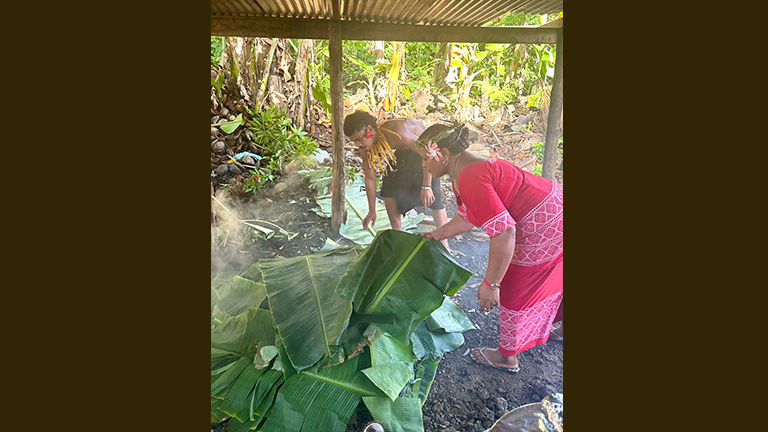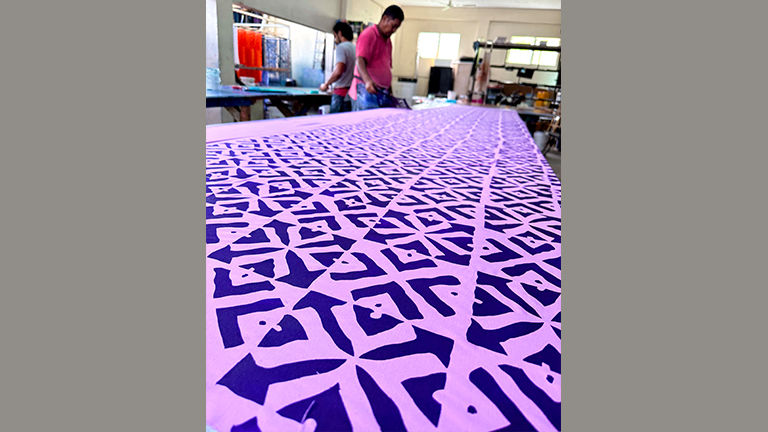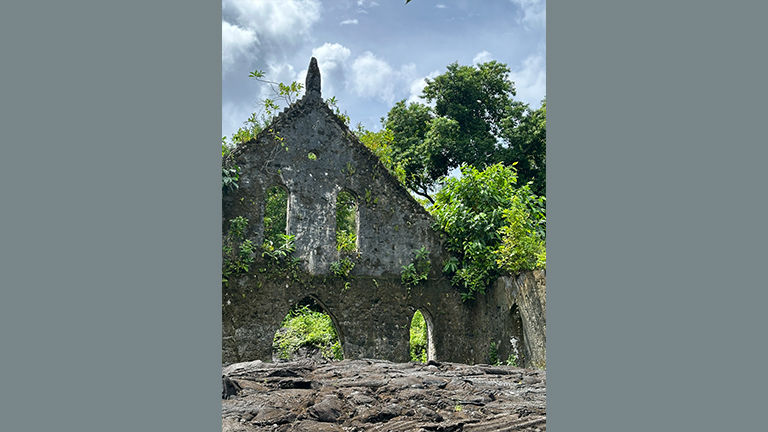As the pile of wood, coconut husks and dried palm fronds burned, waves of heat licked my face while I learned how to prepare palusami. The popular Samoan dish requires pouring a sauce of coconut cream, onions and a touch of salt into a cup of taro leaves before the combination is wrapped up and placed on river stones heated by the fire.
“Pour too quickly, and you will be wearing your dinner instead of eating it,” laughed Ado, my guide.
I was in Samoa to experience Intrepid Travel’s Samoa Adventure — an eight-day tour hopping between Upolu and Savaii islands to not only experience the beautiful natural gifts of the region, but to also spend time learning about traditional culture and village life.
Pass any Samoan village on a Sunday, and travelers will see people cooking outdoors with a traditional umu (earth oven). While my group enjoyed meals with both Samoan and Western dishes on the tour, learning to prepare an umu meal gave me a deeper understanding of life in Samoa.
 Traditional Samoan cooking takes place in an umu (earth oven).
Traditional Samoan cooking takes place in an umu (earth oven).
Credit: 2024 Jill K. Robinson
The itinerary features seven nights in destination, including two in Apia (Samoa’s capital) on Upolu, two in Asau on Savaii and three in Lalomanu on Upolu. Clients should know that this tour is a true adventure, and not your typical beach resort holiday. This tour lets visitors to Samoa get active and spend time in remote villages.
Touring Apia
Guests arrive in Apia on day one, usually via Air New Zealand by way of Auckland or Fiji Airways by way of Nadi. The only activity on that day is a meeting to review the itinerary and introduce traveling companions. The group size is a maximum of 12 clients, not counting the guide and driver, and everyone travels together in a large van.
On day two, our group toured in and around Apia and visited the Fugalei produce and flea market, the Mulivai Cathedral and the Bahai House of Worship. And at Pacific Jewell gift shop, we watched bold patterns of Samoan elei being stenciled on fabric.
 The group watched the creation of patterned fabric.
The group watched the creation of patterned fabric.
Credit: 2024 Jill K. RobinsonA highlight on this day is a visit to the Robert Louis Stevenson Museum, the home where the author lived with his family for the final four years of his life and where he wrote 13 of his books.
Visiting Savaii
The next day, the tour shifted to the island of Savaii after a ferry journey from Upolu. Driving along the island’s ring road, we passed village after village of manicured lawns bordered by hedges of green, yellow, orange and red crotons.
Ado explained that families fish and cultivate the land around their homes with edible and medicinal plants in an attempt to be as self-sufficient as possible. A stop at the Saleaula Lava Field gave us time to hike among the stretches of lava remains from the 1905-1911 eruption of Mount Matavanu.
For our second day on Savaii, we visited the Falealupo peninsula. It’s here in Cape Mulinuu (“land of the last village”) that some of Samoa’s significant legends take place, including the Fafa o Saualii gateway, where spirits of the dead are said to enter into eternity. This is also the home to the Mauga Fetu star mound, which features carved grooves once used for grinding tools and ava (also known as kava) bowls.
 A church stands at the Saleaula Lava Field.
A church stands at the Saleaula Lava Field.
Credit: 2024 Jill K. RobinsonBefore taking the ferry back to Upolu on day five, our group visited the Alofaaga blowholes, where ocean swells spray massive plumes of highly pressurized water and air skyward. It’s hard to turn your attention away from the blowholes, but a pod of spinner dolphins leaping above the waves gave us two spectacles to enjoy.
From there, we drove to the uplands of Savaii, studded with hundreds of volcanic craters. One of them is home to the Afu Aau waterfall, which cascades from a fern-fringed cliff face into a freshwater pool ideal for swimming on a warm day.
After days of driving past beautiful villages, we were welcomed to the village of Vavau in a ceremony held in an open fale (traditional building) used for family and village gatherings. We shared sips of ava with village officials, received fragrant leis and watched a dance performance.
From there, we were invited to the village beach for a traditional lunch that included oka (raw fish marinated in coconut cream) and pork cooked in an umu. It’s not often that visitors have an in-depth welcome in this manner, and Intrepid’s focus on local guides helps make special experiences like this possible.
Fiafia nights of traditional dancing and singing abound in Samoa, and after our final day of swimming in the To Sua Ocean Trench, we attended one of these happy get-togethers at our locally owned accommodation.
They are far more than performances; everyone is invited to participate. While some of these moments inspired laughing along at our attempts at Samoan dance moves, the experience made us feel like truly treasured guests.